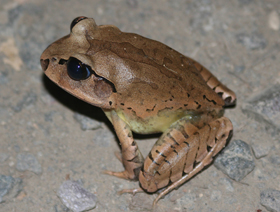Mixophyes Fasciolatus on:
[Wikipedia]
[Google]
[Amazon]
The great barred frog (''Mixophyes fasciolatus'') is an Australian ground-dwelling frog of the genus '' Mixophyes''.
 The great barred frog reaches a size of 8 centimetres and has large, powerful legs. It has a dark brown dorsal surface and a white ventral surface. The thighs are yellow blotched with black and it has parallel black bars along the legs. A dark line begins at the snout, passes through the eye and over the tympanum, and bends down behind the tympanum. Its feet are fully webbed and hands completely un-webbed. Its eyes are on top of the head and the tympanum is visible.
The
The great barred frog reaches a size of 8 centimetres and has large, powerful legs. It has a dark brown dorsal surface and a white ventral surface. The thighs are yellow blotched with black and it has parallel black bars along the legs. A dark line begins at the snout, passes through the eye and over the tympanum, and bends down behind the tympanum. Its feet are fully webbed and hands completely un-webbed. Its eyes are on top of the head and the tympanum is visible.
The
Description
tadpoles
A tadpole is the larval stage in the biological life cycle of an amphibian. Most tadpoles are fully aquatic, though some species of amphibians have tadpoles that are terrestrial. Tadpoles have some fish-like features that may not be found in ...
are quite large, reaching 8.5 centimetres long, and are grey-brown or gold-brown in colour.
Ecology and behaviour
The great barred frog is a ground-dwelling frog which inhabits rainforests, Antarctic beech forests, or wet sclerophyll forests. This frog breeds in both streams and ponds, and it calls from the surrounding land. All the other frogs of the genus ''Mixophyes'' breed only in streams. Themating call
A mating call is the auditory signal used by animals to attract mates. It can occur in males or females, but literature is abundantly favored toward researching mating calls in females. In addition, mating calls are often the subject of mate choic ...
is a very loud "wark-wark-wark" which is occasionally followed by a softer, slow trill "bwaaark-bwaaark".
The male and female great barred frog will enter the water for amplexus
Amplexus (Latin "embrace") is a type of mating behavior exhibited by some externally fertilizing species (chiefly amphibians and horseshoe crabs) in which a male grasps a female with his front legs as part of the mating process, and at the same ...
. After laying the eggs, the female will flick them onto the bank for development. The eggs will then be washed into the stream or pond after the first rain and hatch into tadpoles. The tadpoles take around 12 months to develop into frogs.
The great barred frog is almost always found near running water. Its powerful legs, and webbed feet allow it to escape predation by hopping large distances into water and quickly swimming away.
As a pet
In Australia this animal can be kept in captivity with the appropriate permit.Mark Davidson. 2005. Australian Reptile Keeper Publications.References
* Database entry includes a range map and justification for why this species is of least concern. {{Taxonbar, from=Q2276309 Mixophyes Amphibians of Queensland Amphibians of New South Wales Amphibians described in 1864 Taxa named by Albert Günther Frogs of Australia